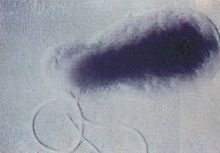Bartonella is a genus of Gram-negative bacteria. It is the only genus in the family Bartonellaceae.[2][3] Facultative intracellular parasites, Bartonella species can infect healthy people, but are considered especially important as opportunistic pathogens.[4] Bartonella species are transmitted by vectors such as fleas, sand flies, and mosquitoes. At least eight Bartonella species or subspecies are known to infect humans.[5]
Bartonella henselae is the organism responsible for cat scratch disease.
- ^ a b c d e f g h "List of Prokaryotic Names with Standing in Nomenclature". Retrieved 28 March 2015.
- ^ Brenner DJ, O'Connor SP, Winkler HH, Steigerwalt AG (1993). "Proposals To Unify the Genera Bartonella and Rochalimaea, with Descriptions of Bartonella quintana comb. nov., Bartonella vinsonii comb. nov., Bartonella henselae comb. nov., and Bartonella elizabethae comb. nov., and To Remove the Family Bartonellaceae from the Order Rickettsiales". International Journal of Systematic Bacteriology. 43 (4): 777–786. doi:10.1099/00207713-43-4-777. ISSN 0020-7713. PMID 8240958.
- ^ Peters D, R. Wigand (1955). "Bartonellaceae". Bacteriol. Rev. 19 (3): 150–159. doi:10.1128/MMBR.19.3.150-159.1955. PMC 180822. PMID 13260099.
- ^ Walker DH (1996). "Rickettsiae". In Baron S, et al. (eds.). Rickettsiae. In: Barron's Medical Microbiology (4th ed.). Univ of Texas Medical Branch. ISBN 978-0-9631172-1-2.
- ^ Chomel BB, Boulouis HJ (2005). "Zoonoses dues aux bactéries du genre Bartonella: nouveaux réservoirs? nouveaux vecteurs?" [Zoonotic diseases caused by bacteria of the genus Bartonella: new reservoirs? new vectors?] (PDF). Bull. Acad. Natl. Med. (in French). 189 (3): 465–77, discussion 477–80. PMID 16149211.
